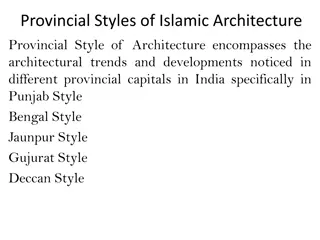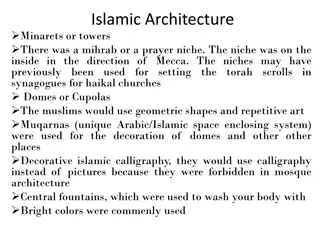Exploring the Marvels of Maya Architecture
Maya architecture is a fascinating reflection of the advanced civilization of the Maya people, showcasing intricate designs, religious significance, agricultural integration, diverse building styles, varied materials, and monumental structures like temples, pyramids, and ball courts. The Maya's expertise in construction techniques and cultural influence are evident in their architectural marvels.
Download Presentation

Please find below an Image/Link to download the presentation.
The content on the website is provided AS IS for your information and personal use only. It may not be sold, licensed, or shared on other websites without obtaining consent from the author. Download presentation by click this link. If you encounter any issues during the download, it is possible that the publisher has removed the file from their server.
E N D
Presentation Transcript
Introduction to Maya Architecture Maya architecture encompasses a wide range of architectural styles and construction techniques used by the Maya people of Mesoamerica. The Maya were a complex and advanced civilization, and their architecture reflects the depth of their knowledge and culture.
Religion in Maya Architecture Religion played a major role in Maya architecture. Maya temples were used for religious ceremonies and rituals, and were usually built atop pyramids. These temples were often decorated with intricate carvings and paintings that depicted Mayan gods and beliefs.
Agriculture in Maya Architecture Agriculture was an important part of Maya architecture. The Maya built terraces and irrigation systems to allow them to cultivate their land, and they also developed advanced methods of storage and preservation to ensure that their food supply was plentiful. They also used their architecture to create shelters for their livestock and tools for farming.
Types of Maya Architecture The Maya were skilled builders and there are many different types of Maya architecture. Examples include: palaces, pyramids, temples, and ball courts. Each of these structures were intricately designed and often featured elaborate decoration and ornamentation.
Maya Building Materials The Maya used a variety of materials to build their structures, including stone, wood, and clay. They also used natural resources such as limestone and obsidian, as well as a variety of paints and dyes to decorate their architecture. They also developed methods of waterproofing their buildings, which allowed them to build in areas where rain was common.
Maya Architectural Styles The Maya developed a variety of architectural styles, each with its own unique characteristics. These styles include: Puuc, Chenes, Chichen Itza, and Tikal. Each of these styles are characterized by their own distinct features, such as the use of step pyramids and sculpted stonework.
Maya Monumental Architecture The Maya are well-known for their monumental architecture. These structures often served a dual purpose, being both elaborate ceremonial centers and sites of political importance. Some examples of monumental architecture include: the Temple of Kukulcan, the Temple of Inscriptions, and the Temple of the Sun.
Maya City Planning Maya city planning was highly organized and advanced. The cities were divided into distinct districts, each of which had a specific purpose and function. There were also strict rules in place to ensure that the cities were clean and orderly. In addition, the Maya employed advanced engineering techniques to construct roads and canals, allowing for easy access within the cities.
Maya Acoustics The Maya also employed advanced acoustical engineering in their architecture. Many of their structures were designed to echo and amplify sound, and they were often used as performance spaces. The acoustics also made it easier for people to communicate and hold conversations in large and noisy spaces.
Maya Cosmology Maya cosmology was closely linked to their architecture. The orientation of many of their structures was important, as they believed that certain directions or cardinal points held power. This belief was reflected in the way they oriented their buildings, as well as their use of symbolism and decoration.
Maya Water Management The Maya were also skilled water managers, and incorporated water features into their architecture. These features included: aqueducts, canals, and reservoirs. These features allowed them to control the supply of water, and also served to beautify their cities.
Maya Astronomy The Maya were knowledgeable astronomers, and their architecture reflected this. Many of their structures were oriented in such a way that they aligned with the stars and planets. They also used astronomical symbols and motifs in the decoration of their temples and pyramids.
Maya Art Maya art was closely linked to their architecture. Many of their structures were decorated with intricate carvings and paintings depicting Mayan gods, beliefs, and mythology. In addition, their art was often used to tell stories, convey messages, and express Mayan culture.
Maya Architecture and Modern Technology The Maya developed advanced construction methods and materials that are still in use today. The use of corbeled vaults and stone columns, as well as the development of waterproofing methods, are examples of Maya architecture that are still used in modern construction.
Summary Maya architecture encompasses a wide range of architectural styles and construction techniques used by the Maya people of Mesoamerica. Religion, agriculture, and art were integral parts of Maya architecture, and their structures were often intricately designed and decorated with symbols and motifs. They also employed advanced construction methods and materials, and many of these are still in use today.























